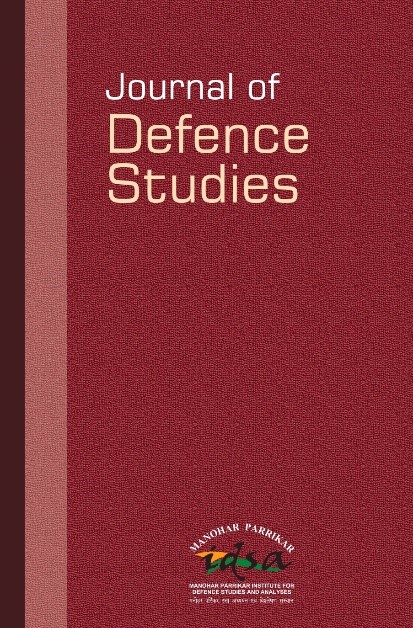You are here
CALL FOR PAPERS

Journal of Defence Studies
Special Issue: Atmanirbharta (Self-Reliance) in Defence and Aeronautics
Deadline for Manuscript Submission: 15 April 2024
 India has set the goals of becoming a developed nation (Viksit Bharat)by 2047 and atmanirbhar (self-reliant) in critical technologies. India has made significant progress in defence, aeronautics, land systems, shipbuilding, drone, space and other technologies over the years, and aspires to become the global drone hub by 2030, for which it would require anusandhan (research), technology development and innovation-led approach.
India has set the goals of becoming a developed nation (Viksit Bharat)by 2047 and atmanirbhar (self-reliant) in critical technologies. India has made significant progress in defence, aeronautics, land systems, shipbuilding, drone, space and other technologies over the years, and aspires to become the global drone hub by 2030, for which it would require anusandhan (research), technology development and innovation-led approach.
While the Defence Research and Development Organisation (DRDO) and Defence Public Sector Undertakings (DPSUs) are playing a critical role in developing niche high-cost technologies, the defence R&D and manufacturing sector has also been opened for the private sector. The synergy among R&D, production, users and finance is essential for making development process efficient. The creation of defence corridors, launching of Innovation for Defence Excellence (iDEX), iDEX Prime and iDEX4Fauji initiatives of Ministry of Defence (MoD), Mehar Baba Competition of Indian Air Force (IAF), Technology Development Fund (TDF) of the DRDO, Delegation of Financial Powers to Defence Forces (DFPDS) and DRDO/Defence Services Centres of Excellence (CoE) in academic institutions provide an opportunity to leverage innovation potential of innovators, academia, start-ups and MSMEs for innovative solutions. These initiatives have helped in indigenous development of innovative technologies like Unmanned Aerial Vehicles (UAVs), Unmanned Surface Vehicles (USVs), Unmanned Underwater Vehicles (UUVs), Unmanned Ground Vehicles (UGVs) and autonomous systems, Artificial Intelligence (AI), Machine Learning (ML), etc. The creation of testing sites, international accreditation of testing laboratories, 24x7x365 availability of facilities and transforming prototypes into commercially viable products are emerging expectations from academic institutions.
India has signed high-tech defence and industrial collaboration agreements with global partners and transforming them into mutually beneficial technological partnerships would require structural and policy reforms and change of mindsets of partner countries. Indian defence forces including Headquarters Integrated Defence Staff (HQ IDS) need to deliberate on the need for creating R&D verticals and structures to steer and participate in R&D and co-development projects with Indian industry and global partners. There is a need to develop an understanding of nuances and challenges in exporting defence products in the global market and accordingly improve structures, polices and their implementation. India needs corresponding civil aeronautics and industrial atmanirbharta policies, R&D structures and initiatives to achieve Civil–Military Fusion.
Taking into account the developments and challenges faced in the initiatives being taken, and the course corrections required for achieving the goal of Atmanirbhar Viksit Bharat @2047, the Journal of Defence Studies is planning to bring out a special issue on “Atmanirbharta (Self-Reliance) in Defence and Aeronautics” and is inviting contributions for the same.
Topics of Interest
- History of Defence and Aeronautics Technology Development in India
- Atmanirbharta (Self-Reliance) in Defence and Aeronautics
- Defence Acquisition Procedures (DAP) for Self-Reliance
- Public–Private Partnership in Defence Technology Development
- Strengths and Limitations of Private Sector
- Potential of Start-ups and MSMEs in Innovation and their Challenges
- iDEX, Mehar Baba Competition, Technology Development Fund (TDF) and Other Defence Technology Initiatives for Private Sector
- Research, Development and Innovation (RD&I) in Defence Forces
- Nuances of DTTI, INDUS-X, iCET and Co-development with Global Partners
- R&D Ecosystem for Self-reliance
- Technology Architecture for Development and Integration of Drones in India
- Academia as an Enabler and a Partner
- Defence Exports: Opportunities and Challenges
- Atmanirbharta in Civil Aeronautics for Civil–Military Fusion
- Leadership, Ownership, Accountability and Synergy for Self-Reliance
|
Submission: |
Guidelines for Contributors
JDS Special Issue: Atmanirbharta (Self-Reliance) in Defence and Aeronautics
Manuscript submission: Articles ranging between 4,000 and 8,000 words and commentaries/perspective pieces of about 2,000–3,000 words may be sent to the Associate Editor, Journal of Defence Studies at jds.mpidsa@gov.in latest by 15 April 2024.
Format
- Manuscripts need to be submitted in MS Word format (2003/2007/newer versions). The text (including notes) should be typed in Times New Roman, 12 pt with 1.5 line spacing and standard margins.
- An abstract of about 100–150 words and 5–6 keywords should be provided in the articles.
- British spellings with ‘s’ variant should be used, i.e., ‘analyse’, ‘organise’, ‘specialisation’, ‘labour’, etc.
- Single quotation marks should be used consistently and use double quotation marks for indicating quoted matter within quotations.
- Tables/Figures/Maps/Images should be numbered sequentially, with appropriate captions, source details and call-outs in the text.
References
All citations/references to others’ works should be clearly mentioned in the notes (footnotes), with a corresponding note cue in the text. The format is mentioned below.
Book: Liang Zhang, Andrew J. Nathan, Perry Link and Orville Schell, The Tiananmen Papers:TheChineseLeadership’s Decisionto Use Force Against theirOwnPeople—In TheirOwnWords, Public Affairs, New York, 2001.
Edited Volume: Ashley Tellis, Mercy Kuo and Andrew Marble (eds), StrategicAsia2008–09: Challengesand Choices, National Bureau of Asian Research, Seattle, 2008.
Chapter in an Edited Volume: T. Jayaraman, Tejal Kanitkar and Mario D’Souza, ‘Equity and Burden Sharing in Emission Scenarios: A Carbon Budget’, in Navroz Dubash (ed.), HandbookofClimate Changeand India:Development,Politicsand Governance, Oxford University Press, New Delhi, 2012, pp. 140–46.
Journal Article: Arthur A. Stein, ‘Coordination and Collaboration: Regimes in an Anarchic World’, International Organization, Vol. 36, No. 2, 1982, pp. 99–114.
Web Reference: Vladimir Radyuhin, ‘INS Vikramaditya Begins Sea Trials’, TheHindu, 8 June 2012, available at http://www.thehindu.com/news/international/article3503982.ece, accessed on 8 June 2012.
